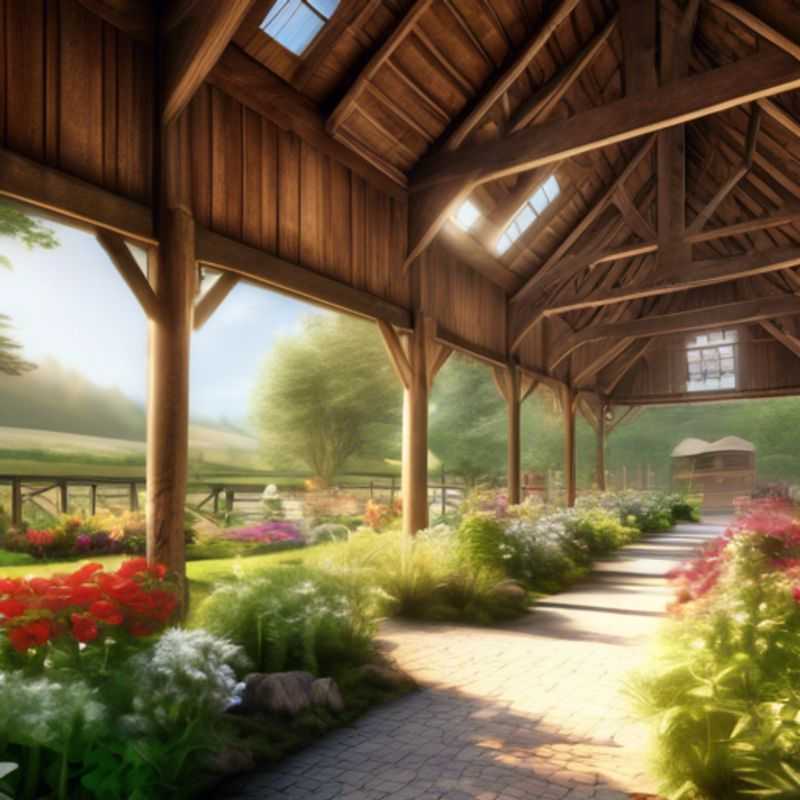Top Things to Know Before Buying a Garden Barn

Top Things to Know Before Buying Your Garden Barn: From Space Measurement to Warranty Coverage
Ah, the Garden Barn. A delightful addition to any green thumb's domain. But before you dive headfirst into the world of wooden structures, let's pause for a moment and consider a few critical factors. It's all about making sure your new barn is not just a beautiful addition, but also a practical one that serves you well for years to come.
First things first, measure twice, cut once - or in this case, measure twice, buy once.

Measuring for Success: How to Ensure Your Garden Barn Fits Perfectly
Before you get excited about that beautiful garden barn you’ve got your eye on, there’s a crucial first step: making sure it’ll actually fit in your garden. Don’t worry, it’s not rocket science (though I do love me some good engineering!), but it’s definitely important to get the measurements right.
First things first, grab a measuring tape, it’s going to be your best friend! You’ll need to measure the length, width, and height of the space where you want to put your barn. Don’t forget to consider any obstacles like trees, fences, or even your shed if you already have one.
Now, it’s time to take a look at the dimensions of the barn itself. This information should be readily available from the manufacturer, either online or in their brochures.
The next step is to compare your measurements. Make sure there’s enough clearance on all sides for the barn to fit comfortably. You’ll need to add some extra space for things like doors, windows, and the ability to open them fully without obstruction. A rule of thumb is to add at least a foot of clearance on each side, but you’ll want to check what the manufacturer recommends.
Don't forget to factor in the foundation! You’ll need to check whether the chosen spot for your barn is level and whether the ground is solid enough to support its weight. You may need to consider a concrete base or a raised platform.
Planning ahead with these simple steps will save you headaches and ensure that your garden barn fits perfectly! After all, we want to ensure it's a delightful addition to your garden, not a source of frustration. Remember, you can always consult with a landscape architect or contractor for professional assistance, especially if your site presents unique challenges.

Building for the Long Haul: Inspecting Materials for Durability and Weather Resistance
Choosing the right materials for your construction project is crucial for its long-term performance, especially when considering durability and weather resistance. This guide will give you a summary of key factors to assess when selecting materials.
Durability refers to a material's ability to withstand wear, tear, and degradation over time. Consider factors like:
• Material strength: The ability to resist forces like compression, tension, and shear.
• Resistance to impact: The material's ability to withstand sudden shocks without breaking or cracking.
• Resistance to abrasion: The ability to resist wear and tear from friction.
Weather resistance is crucial for any construction project. Key aspects to consider are:
• Water resistance: The ability to withstand moisture without deteriorating, warping, or rotting. This is important for everything from foundations to roofing.
• UV resistance: The ability to resist damage caused by ultraviolet radiation from the sun. This is particularly important for exterior materials like paint, siding, and roofing.
• Temperature resistance: The ability to withstand extreme temperatures without cracking, warping, or losing structural integrity.
Remember, there's no one-size-fits-all solution. The best materials will depend on your specific project, climate, and budget. For detailed information on specific materials, always consult with professionals and do your own research.

Deciphering the Blueprint: A Guide to Understanding Assembly Instructions
Reviewing assembly instructions before starting a project is crucial for understanding its complexity. This step helps in estimating the time, tools, and skills needed for the build.
Read the instructions thoroughly to get a clear understanding of the project's scope. Identify the number of steps, the types of tools and materials required, and any special techniques involved. Pay attention to warnings and safety precautions.
Look for visual aids like diagrams, illustrations, and exploded views. They provide a clear visual representation of the assembly process, making it easier to understand the steps.
Evaluate the complexity of the instructions. Are they straightforward with simple steps, or do they require advanced skills and knowledge? The complexity can vary from simple household items to intricate electronics or furniture.
Consider the time commitment. Estimate the time required for each step and factor in any potential delays. It's better to overestimate the time than underestimate it and face last-minute pressure.
Check for required tools and materials. Ensure you have all the necessary tools and materials before you begin. This can prevent delays and frustration later on.
Consider the possibility of professional help. If the instructions seem overwhelming, or if you lack certain skills, consider hiring a professional to assist with the assembly. Professional assembly services can offer expertise and ensure the project is completed correctly.

Warranty Coverage: What to Ask Before Installation
When you're investing in a new appliance or product, it's crucial to understand the warranty coverage. This safeguard is crucial for protecting your investment and ensuring peace of mind during the initial ownership period. Always inquire about the warranty period and what it covers before purchasing a product. You can find this information in the product manual, on the manufacturer's website, or by contacting their customer service department. Understanding the warranty details, including the coverage period, what's included, and what's excluded, will be invaluable in the event of any issues arising after installation.
For example, you might want to know if the warranty covers labor costs for repairs, or if there are any specific components that are excluded. Understanding the warranty's limitations can help you make informed decisions and prepare for potential costs if a repair is required. It's always a good practice to retain a copy of your warranty documentation for future reference. It can help you avoid any disputes or unexpected expenses down the road.
Remember, warranties are designed to protect both the customer and the manufacturer. By understanding the terms and conditions of your warranty, you can ensure that your rights are protected, and your investment is safeguarded.

Digging Deeper: Researching Brand Reputation and Customer Reviews for Quality and Service
When considering a purchase, researching a brand's reputation and customer reviews is crucial. This can provide invaluable insights into the quality of their products and services, as well as their commitment to customer satisfaction. Online reviews are an excellent starting point. Platforms like Trustpilot, Google Reviews, and Yelp offer a diverse range of consumer opinions. Look for patterns in the feedback, paying attention to common themes such as product quality, customer service, and overall satisfaction.
Beyond online platforms, exploring forums and social media groups dedicated to the brand or product can provide a deeper understanding. These often contain detailed discussions and real-life experiences from users. Consider checking industry publications and news articles as well. They can offer insights into the brand's performance, its history, and any major controversies or customer complaints. Remember, a balanced approach is key. While positive reviews are encouraging, negative feedback should be taken seriously. It's often more telling than a string of perfect scores.
Analyzing the brand's response to negative reviews is crucial. Do they acknowledge and address customer concerns? Are they proactive in resolving issues? These actions demonstrate their commitment to customer service and their willingness to improve. By diligently researching a brand's reputation, you can make informed decisions and avoid potential headaches down the line.

Foundation First: How to Determine If Your Garden Barn Needs Levelling
Deciding whether a foundation or leveling is necessary for your garden barn depends on several factors, primarily the size and weight of the barn and the nature of your soil.
Smaller, lightweight garden sheds, especially those constructed from plastic or lightweight wood, might not require a full foundation. However, even these structures benefit from a level base to ensure stability and prevent water pooling underneath. For these, a simple gravel pad or a layer of compacted sand can suffice.
Larger, heavier garden sheds, especially those made from wood or metal, absolutely require a foundation for proper stability. A concrete slab foundation is the most robust and durable option, offering protection from moisture, frost, and pests. This option is typically recommended for larger, heavier structures or those intended for storage of valuable items.
Remember, proper leveling is crucial for any garden shed, regardless of the foundation type. Uneven ground can lead to instability and damage to the structure over time. Invest in a leveling tool or consult a professional for assistance in ensuring a level surface for your garden barn.
When considering foundation costs, factor in material expenses (concrete, gravel, etc.) and potential labor costs for professional installation. If you are considering a DIY approach, research local building codes and regulations to ensure compliance.

Don't Forget the Extras: Accounting for Accessories and Customizations
When considering the cost of any purchase, especially one involving technology, remember to factor in the cost of any additional accessories or customizations you may want. This often gets overlooked, leading to budget overruns and disappointment. Think about the complete picture, not just the initial price tag.
Accessories can range from essential items like cases and screen protectors to more specialized items like external hard drives, memory cards, or styluses. Customizations could include software upgrades, extended warranties, or personalized engravings.
Don't underestimate the impact of these additions on your overall budget. Take the time to research the cost of these extras beforehand. This will help you make informed decisions and ensure you're not caught off guard by unexpected expenses.
Remember, even small expenses can add up quickly. It's better to budget for them upfront than to find yourself scrambling for additional funds later. A little planning can go a long way in ensuring a smoother and more enjoyable purchase experience.
